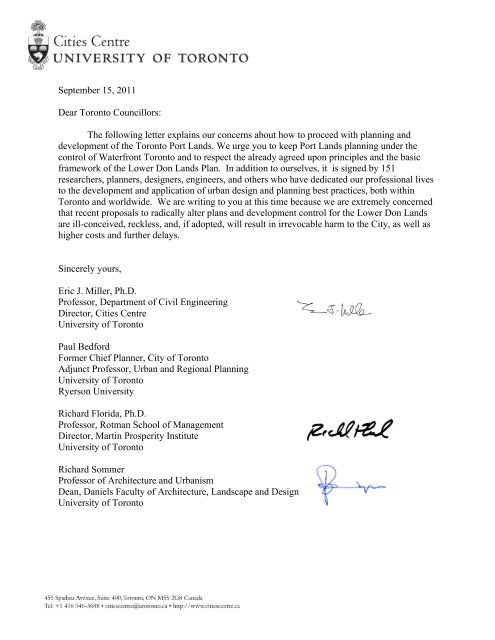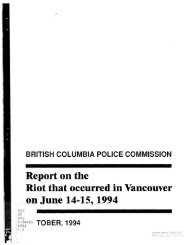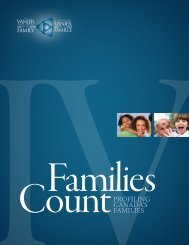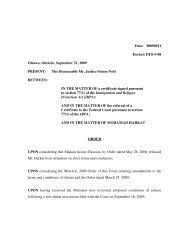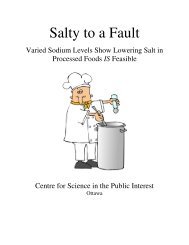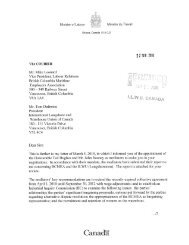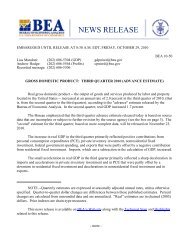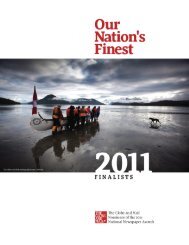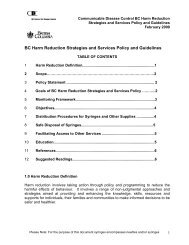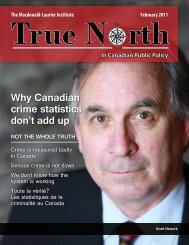September 15, 2011 - The Globe and Mail
September 15, 2011 - The Globe and Mail
September 15, 2011 - The Globe and Mail
You also want an ePaper? Increase the reach of your titles
YUMPU automatically turns print PDFs into web optimized ePapers that Google loves.
<strong>September</strong> <strong>15</strong>, <strong>2011</strong><br />
Dear Toronto Councillors:<br />
<strong>The</strong> following letter explains our concerns about how to proceed with planning <strong>and</strong><br />
development of the Toronto Port L<strong>and</strong>s. We urge you to keep Port L<strong>and</strong>s planning under the<br />
control of Waterfront Toronto <strong>and</strong> to respect the already agreed upon principles <strong>and</strong> the basic<br />
framework of the Lower Don L<strong>and</strong>s Plan. In addition to ourselves, it is signed by <strong>15</strong>1<br />
researchers, planners, designers, engineers, <strong>and</strong> others who have dedicated our professional lives<br />
to the development <strong>and</strong> application of urban design <strong>and</strong> planning best practices, both within<br />
Toronto <strong>and</strong> worldwide. We are writing to you at this time because we are extremely concerned<br />
that recent proposals to radically alter plans <strong>and</strong> development control for the Lower Don L<strong>and</strong>s<br />
are ill-conceived, reckless, <strong>and</strong>, if adopted, will result in irrevocable harm to the City, as well as<br />
higher costs <strong>and</strong> further delays.<br />
Sincerely yours,<br />
Eric J. Miller, Ph.D.<br />
Professor, Department of Civil Engineering<br />
Director, Cities Centre<br />
University of Toronto<br />
Paul Bedford<br />
Former Chief Planner, City of Toronto<br />
Adjunct Professor, Urban <strong>and</strong> Regional Planning<br />
University of Toronto<br />
Ryerson University<br />
Richard Florida, Ph.D.<br />
Professor, Rotman School of Management<br />
Director, Martin Prosperity Institute<br />
University of Toronto<br />
Richard Sommer<br />
Professor of Architecture <strong>and</strong> Urbanism<br />
Dean, Daniels Faculty of Architecture, L<strong>and</strong>scape <strong>and</strong> Design<br />
University of Toronto
Dear Councillor:<br />
This open letter explains the reasons for urging you to reject efforts to remove Port L<strong>and</strong>s<br />
planning from Waterfront Toronto <strong>and</strong> to ab<strong>and</strong>on its vision. Our judgement is based on both the<br />
facts of the case <strong>and</strong> our collective extensive experience with city-building in a wide variety of<br />
contexts <strong>and</strong> cities, including other waterfront developments.<br />
We have six main points to offer:<br />
1. Flawed Reasoning. <strong>The</strong> facts concerning Waterfront Toronto’s history, performance <strong>and</strong><br />
current plans have been misrepresented in the recent Port L<strong>and</strong>s proposal endorsed by the<br />
Mayor. <strong>The</strong> alternative vision is deeply flawed. In particular:<br />
• <strong>The</strong> Mayor’s main justification for a change of plan is that little progress has been made,<br />
<strong>and</strong> somebody has to break the logjam. This is simply incorrect, as over the last 10 years<br />
we have seen major progress on the waterfront, including the waterfront promenade, new<br />
piers, wave decks, Canada’s Sugar Beach, Sherbourne Common, Don River Park<br />
floodproofing berm, <strong>and</strong> Underpass Park. <strong>The</strong> Corus Entertainment building <strong>and</strong> George<br />
Brown College were attracted to the waterfront by this extensive public realm<br />
investment. <strong>The</strong> West Donl<strong>and</strong>s area is now starting construction <strong>and</strong> the East Bayfront<br />
has attracted a major developer to build the vision outlined in the precinct plan. <strong>The</strong><br />
Mayor’s approach on the contrary is likely to slow down progress on the next stages as<br />
development moves towards the Port L<strong>and</strong>s, because of added uncertainty, replication of<br />
environmental assessment processes, OMB challenges, etc.<br />
• Furthermore, the Mayor’s assertion that his alternative proposal, which includes heavy<br />
reliance on the private sector, can do this faster <strong>and</strong> better, is not credible. In a<br />
redevelopment of this size it is essential for a body like Waterfront Toronto to create the<br />
public realm first <strong>and</strong> provide the context within which the private sector can build.<br />
Investing in the public realm first substantially increases the l<strong>and</strong> value <strong>and</strong> attracts high<br />
quality developments. <strong>The</strong> public corporation can then sell or lease l<strong>and</strong> with all the<br />
approvals in place <strong>and</strong> reinvest the funds into achieving the public planning objectives<br />
that are clearly spelled out in the Central Waterfront Plan <strong>and</strong> precinct plans.<br />
• At the foundation of the Mayor’s criticism of the existing plan, is the suggestion that l<strong>and</strong><br />
that will be devoted to ecologically remaking the mouth of the Lower Don River<br />
somehow represents a loss of valuable l<strong>and</strong>. This is absolutely false from a real estate,<br />
l<strong>and</strong> development, value creation <strong>and</strong> ecological perspective. An investment in<br />
transforming the infrastructure <strong>and</strong> parkl<strong>and</strong>, transportation infrastructure, <strong>and</strong> other<br />
amenities, including well-designed streets <strong>and</strong> everyday cultural facilities will make the<br />
rest of the l<strong>and</strong> much more valuable over time, more than compensating for the l<strong>and</strong><br />
devoted to parks <strong>and</strong> ecological functions.<br />
2. A Flawed Vision. <strong>The</strong> proposed plans do not represent a “bold new vision” for our<br />
Waterfront. Rather, they are a tired recycling of 1960’s thinking. <strong>The</strong> Lower Don L<strong>and</strong>s are not<br />
Disney World. <strong>The</strong> current plan is an award-winning design that will create a whole new<br />
community on the waterfront that will be a model for sustainable urban development. <strong>The</strong> new<br />
proposals represent yet another attempt to bring failed suburban urban design concepts into a<br />
downtown setting. Such ideas are being rejected around the world in cities that Toronto is<br />
attempting to compete with for economic development. For Toronto to take such a step into the<br />
2
past when its competitors are boldly stepping into the future is a strategic mistake of the first<br />
order. If implemented, not only will these new proposals have dire consequences for the entire<br />
Toronto East End, they will represent a failure to capitalize on the once-in-a-lifetime opportunity<br />
that we have to “get it right”.<br />
3. An Inferior Plan. <strong>The</strong> elements of the alternative plan so far released to the press quite<br />
simply are shockingly inferior to the current plan. In particular:<br />
• <strong>The</strong> Lower Don L<strong>and</strong>s plan already provides for a large amount of retail space, both for<br />
residents <strong>and</strong> visitors, but with active urban shopping streets rather than a megamall. <strong>The</strong><br />
proposed “destination shopping” complex is simply a very bad idea for many reasons.<br />
First, the need does not exist for another major shopping mall in the downtown:<br />
Councillor Ford’s assertion that there isn’t enough retail outside the Eaton Centre will<br />
come as a surprise to the thous<strong>and</strong>s of store owners <strong>and</strong> tens of thous<strong>and</strong>s of retail<br />
employees in downtown Toronto. Building a megamall would have a major negative<br />
impact on the retail core <strong>and</strong> especially all the successful retail strips that have devoted<br />
huge efforts at revitalization through BIA's <strong>and</strong> hard work. Second, placing a major mall<br />
in this location would generate a transportation nightmare for the Toronto East End<br />
requiring a parking dem<strong>and</strong> of approximately 6,000 spaces based on conventional<br />
st<strong>and</strong>ards which is a waste of valuable waterfront l<strong>and</strong>. <strong>The</strong> overwhelming majority of<br />
shoppers travelling to this mall would come by car <strong>and</strong> would continue to do so once the<br />
spaces were provided. In addition, the road system in the East End could not reasonably<br />
accommodate this additional burden, leading to significantly increased congestion on our<br />
roads <strong>and</strong> a significant degradation in the quality of life for all East End residents.<br />
• <strong>The</strong> proposed monorail is a technically inferior option to the recently cancelled LRT line.<br />
<strong>The</strong> proposed alternative would not be able to h<strong>and</strong>le the volume or diversity of<br />
anticipated user needs. A transit focused waterfront would be ab<strong>and</strong>oned in the process.<br />
• Malls do not represent a sustainable vision for prime waterfront l<strong>and</strong>s in Toronto. In the<br />
U.S. 20% of the 2,000 malls are failing <strong>and</strong> a staggering half a billion square feet of retail<br />
space lies empty. Even Wal Mart has ab<strong>and</strong>oned 400 stores across the U.S. <strong>The</strong> great<br />
irony in our current debate is that in many of these U.S. locations planning efforts are<br />
underway to convert dead malls into mixed use centres with lots of residential<br />
development! Here the proposal is to do the reverse. While the Toronto economy is<br />
certainly stronger than in many parts of the U.S., no logical evidence has been presented<br />
as to why this proposal for constructing massive amounts of new retail space is<br />
warranted, either as an economic development or an urban development strategy.<br />
• Re-naturalizing the mouth of the Don through the three outlets of the existing plan<br />
achieves flood-proofing while the Mayor's plan does not. It maintains the hard edge<br />
Keating channel <strong>and</strong> allows for the water to simply flood a north-south park <strong>The</strong> proposal<br />
will remove a lot of public park l<strong>and</strong>, which is important both environmentally <strong>and</strong> as an<br />
attractive public space, much as in Chicago’s waterfront.<br />
• <strong>The</strong> existing plan can be financed from increased l<strong>and</strong> values <strong>and</strong> resulting tax revenues.<br />
• Given the plethora of giant Ferris wheels already in existence around the world, the<br />
notion of building one here on precious waterfront l<strong>and</strong> is hardly a novel idea or one that<br />
will put Toronto “on the map” as a tourist attraction. In functional terms it is also largely<br />
redundant, given the existence of the CN Tower, a truly iconic symbol for the City <strong>and</strong><br />
one that already provides spectacular views of the City <strong>and</strong> the Lake.<br />
3
4. Delays. <strong>The</strong> new proposal would also require a new Environmental Assessment, precinct plan<br />
Official Plan Amendments, zoning <strong>and</strong> public consultations. This would take years <strong>and</strong> would<br />
result in a guaranteed major OMB hearing. In the meantime, major developers who are now<br />
ready to invest <strong>and</strong> build in accordance with the existing Plan would be put on hold <strong>and</strong> may go<br />
elsewhere. Rather than speeding up the process of developing the Port L<strong>and</strong>s, it will almost<br />
certainly slow it down. Contrary to assertions that have been made, Waterfront Toronto has been<br />
moving as expeditiously as possible to develop the Lower Don L<strong>and</strong>s in a professionally<br />
responsible <strong>and</strong> market responsive manner. <strong>The</strong> new proposals can only serve to seriously<br />
interrupt <strong>and</strong> delay the current momentum.<br />
5. Long-Term City Building. Further, despite the Mayor’s claims, the proposed new plan is<br />
not, in fact, an exercise in city building at all. Rather, at its core it seems to be simply a<br />
desperate attempt to sell off extremely valuable city assets at bargain basement prices to<br />
developers to raise a one-time contribution towards reducing the City’s deficit. <strong>The</strong> “city<br />
building argument” is just window-dressing for a l<strong>and</strong> deal that will benefit the parties involved<br />
but that will leave the City much poorer in the long run. <strong>The</strong> extreme short-sightedness of this<br />
should be apparent to all. <strong>The</strong> Waterfront is a legacy that we need to preserve <strong>and</strong> pass down to<br />
future generations. We don’t sell our house if we fall behind on a credit card payment – we find<br />
other <strong>and</strong> far better ways of paying off the debt, <strong>and</strong> we keep the house for our own <strong>and</strong> our<br />
children’s use long into the future. If we sell this l<strong>and</strong> off to private interests we will never get it<br />
back, <strong>and</strong> we will do major permanent damage to what should become a vital <strong>and</strong> exceptional<br />
part of the downtown core.<br />
6. Consultation <strong>and</strong> Democratic Process. <strong>The</strong> backroom nature of this proposal, the lack of<br />
open consultation <strong>and</strong> the absence of City staff input into the process are inexcusable given the<br />
years of extensive consultation associated with the existing plan. This mode of decision-making<br />
represents a very serious step backwards in the governance of the City, <strong>and</strong>, over <strong>and</strong> above the<br />
immediate threat it poses for proper development of the Lower Don L<strong>and</strong>s, it poses a very real<br />
threat to democratic decision-making in the City. Without open <strong>and</strong> transparent processes,<br />
without consultation of both the publics affected <strong>and</strong> City staff, <strong>and</strong> without Council exercising<br />
independent judgement over decisions extremely poor decisions will all too often occur. When<br />
these decisions so clearly benefit a privileged few to the detriment of everyone else, then<br />
government is simply not doing its job. In the case of the recent proposal for the Port L<strong>and</strong>s, it is<br />
not clear that anyone st<strong>and</strong>s to benefit except a developer or two, while the entire City (<strong>and</strong><br />
particularly the residents of its east end) will suffer from increased traffic congestion <strong>and</strong>, even<br />
more critically, the lost opportunity to build a major new sustainable waterfront community on<br />
the edge of the existing downtown.<br />
Further:<br />
• <strong>The</strong> proposal violates the four core principles embodied in the "Making Waves" Central<br />
Waterfront Plan that was adopted unanimously in 2003 by Council.<br />
• It represents a complete retreat from the position successfully argued by the City at the<br />
OMB hearing that dealt with the November 10, 1999 Home Depot proposal for a 10,000<br />
square metre suburban-style Home Depot store surrounded by surface parking at<br />
Lakeshore <strong>and</strong> Cherry. <strong>The</strong> hearing deemed that the construction of major retail facilities<br />
on these l<strong>and</strong>s was an inappropriate use of the l<strong>and</strong>, which should be maintained for<br />
4
higher <strong>and</strong> better uses (OMB Decision Order 2059).<br />
• <strong>The</strong> existing Lower Don Scheme was selected as part of an international design<br />
competition in which some of the most innovative, <strong>and</strong> internationally recognized <strong>and</strong><br />
celebrated architects, l<strong>and</strong>scape architects, urban designers, ecologists, planners, <strong>and</strong><br />
economic development consultants participated. <strong>The</strong> selected team – including Ken<br />
Greenberg <strong>and</strong> Michael R. Van Valkenburgh – has successfully remade the waterfront of<br />
Brooklyn, among other cities to great effect <strong>and</strong> acclaim. Because of the Don <strong>and</strong> other<br />
Waterfront Toronto projects, the transformation of Toronto's waterfront has become an<br />
object of worldwide interest <strong>and</strong> study. This alone has added value to the city of Toronto<br />
<strong>and</strong> continues to increase its st<strong>and</strong>ing on the world stage.<br />
• <strong>The</strong> proposal by CivicArts /Eric Kuhne has not been vetted through such a process of<br />
international competition, <strong>and</strong> it is uncertain that it would st<strong>and</strong> up to the scrutiny of a<br />
serious, independent jury or review panel.<br />
It is appropriate for cities to review undertakings from time to time, but current Port L<strong>and</strong>s<br />
planning needs to be kept under the control of Waterfront Toronto <strong>and</strong> to respect the already<br />
agreed upon principles <strong>and</strong> the basic framework of the Lower Don L<strong>and</strong>s Plan. Radical <strong>and</strong><br />
erratic changes of direction send the wrong signals to investors, the public, <strong>and</strong> to all those who<br />
participated for so many years in the creation of an already approved plan.<br />
For all these reasons we ask that you as Councillors approach this vital question carefully <strong>and</strong><br />
with an eye to the future of the City in your charge.<br />
Sincerely yours,<br />
Eric J. Miller, Ph.D.<br />
Professor, Department of Civil Engineering<br />
Director, Cities Centre<br />
University of Toronto<br />
Paul Bedford<br />
Former Chief Planner, City of Toronto<br />
Adjunct Professor, Urban <strong>and</strong> Regional Planning<br />
University of Toronto <strong>and</strong> Ryerson University<br />
Richard Florida, Ph.D.<br />
Professor, Rotman School of Management<br />
Director, Martin Prosperity Institute<br />
University of Toronto<br />
Richard Sommer<br />
Professor of Architecture <strong>and</strong> Urbanism<br />
Dean, Daniels Faculty of Architecture, L<strong>and</strong>scape <strong>and</strong> Design<br />
University of Toronto<br />
5
ADDITIONAL SIGNATORIES<br />
David Amborski, MCIP RPP<br />
Professor, School of Urban <strong>and</strong> Regional Planning, Ryerson University<br />
Caroline Andrew,<br />
Director, Centre on Governance, University of Ottawa<br />
Robert G Barton,<br />
Senior Technical Engineer, Ontario Power Generation - Pickering Nuclear.<br />
Philip Beesley<br />
Professor, Waterloo Architecture MRAIC OAA RCA<br />
Jody Berl<strong>and</strong><br />
Professor <strong>and</strong> Senior Faculty Associate, Robarts Centre for Canadian Studies, York University<br />
Brent Berry<br />
Associate Professor, Department of Sociology, University of Toronto<br />
Diana Birchall,<br />
Director of Policy Planning/Urban Design City of Vaughan<br />
Adrian Blackwell, BArch, MUD<br />
Assistant Professor, John H. Daniels Faculty of Architecture, L<strong>and</strong>scape, <strong>and</strong> Design, University of<br />
Toronto<br />
Shirley Blumberg,<br />
KPMB Architects Canada<br />
Caitlin Blundell, MA.<br />
Shauna Brail, PhD<br />
Senior Lecturer, Urban Studies Program, University of Toronto<br />
Terri Meyer Boake<br />
Associate Professor, Associate Director, School of Architecture, University of Waterloo<br />
Past President Society of Building Science Educators, President Elect Building Technology Educators<br />
Society, Member of Ontario Association of Architects Committee on Sustainable Built Environment<br />
Larry S. Bourne Ph.D. FRSC MCIP<br />
Professor emeritus, Geography <strong>and</strong> Planning, University of Toronto<br />
Beate Bowron,<br />
Former Director of Community Planning, City of Toronto<br />
Jennifer C. Bukovec, BES, MLA<br />
Center for L<strong>and</strong>scape Research, Daniels Faculty of Architecture, L<strong>and</strong>scape <strong>and</strong> Design, University of<br />
Toronto<br />
Ron Buliung, Ph.D.<br />
Associate Professor, Department of Geography, University of Toronto Mississauga<br />
Susannah Bunce, Ph.D.<br />
Assistant Professor, Department of Social Sciences, University of Toronto Scarborough<br />
6
Wayne Caldwell, PhD, RPP, MCIP<br />
Director <strong>and</strong> Professor, School of Environmental Design <strong>and</strong> Rural Development, University of Guelph<br />
Martin Cleaver M.Sc MBA<br />
Joseph Clement, MFA OCAD<br />
William Jeffrey Cock, HBA, MLA<br />
Associate Member - OALA<br />
Tom Cohen<br />
Department of History, York University<br />
Carina Cojeen<br />
Citizen urbanist, Brockton Village resident<br />
Tenley Conway, Ph.D.<br />
Associate Professor, Department of Geography, University of Toronto, Mississauga<br />
S<strong>and</strong>ra Cooke, OALA, CSLA<br />
Anna Cote<br />
Masters of Environmental Studies <strong>and</strong> Planning (C<strong>and</strong>idate), York University<br />
Deborah Cowen, Ph.D.<br />
Assistant Professor, Department of Geography, Research Associate, Cities Centre<br />
University of Toronto<br />
Frank Cunningham, Ph.D. FRSC,<br />
Senior Advisor, Cities Centre, University of Toronto<br />
Prof. John Danahy<br />
Director Centre for L<strong>and</strong>scape Research John H. Daniels Faculty of Architecture, L<strong>and</strong>scape, <strong>and</strong><br />
Design University of Toronto<br />
Amrita Daniere Ph.D.<br />
Vice Dean Graduate, University of Toronto Mississauga, Professor of Geography <strong>and</strong> Planning<br />
Annahid Dashtgard,<br />
Senior Partner, Anima Leadership on behalf of all Anima Leadership Staff<br />
Elaine Davies, Mississauga, Ontario<br />
Gene Desfor, Ph.D.<br />
Professor Emeritus, York University<br />
Christopher De Sousa, Ph.D.<br />
Associate Professor, Director, School of Urban <strong>and</strong> Regional Planning, Ryerson University<br />
Richard DiFrancesco, Ph.D.<br />
Associate Professor, Geography <strong>and</strong> Planning, University of Toronto<br />
Mike Dror<br />
M.Plan C<strong>and</strong>idate, Queen's University<br />
Douglas Duckworth<br />
7
MScPl C<strong>and</strong>idate, Department of Geography <strong>and</strong> Programme in Planning, University of Toronto<br />
Roger du Toit, MCIP, RPP, FRAIC, OAA, OALA, AIPP<br />
Gabriel Eidelman<br />
PhD C<strong>and</strong>idate, Dept. of Political Science, University of Toronto<br />
Matthew Farish, Ph.D.<br />
Associate Professor, Department of Geography <strong>and</strong> Program in Planning, University of Toronto<br />
Lesley-Ann Foulds, BSc. Civil Engineering, Environmental Engineering Minor<br />
Engineering Trainee with Ontario Power Generation - Pickering Nuclear<br />
Jennifer Foster, Ph.D. RPP<br />
Associate Professor, Faculty of Environmental Studies, York University<br />
Gail Fraser, Ph.D.<br />
Faculty of Environmental Studies, York University<br />
Frances Frisken<br />
Professor Emeritus, Political Science, York University<br />
Josh Fullan,<br />
Chair, People Plan Toronto<br />
Michelle Gay,<br />
Chair, Active 18 Community Association<br />
Emily Gilbert, Ph.D.<br />
Associate Professor, Department of Geography, Director, Canadian Studies Program, University of<br />
Toronto<br />
David L. A. Gordon, Ph.D. MCIP AICP P. Eng.<br />
Professor <strong>and</strong> Director, School of Urban <strong>and</strong> Regional Planning, Queen's University<br />
Ken Greenberg,<br />
Greenberg Consultants<br />
Paul Hess, Ph.D.<br />
Associate Professor, Director, Program in Planning, Dept. of Geography & Program in Planning,<br />
University of Toronto<br />
J. David Hulchanski, Ph.D.<br />
Professor, Cities Centre & Social Work, University of Toronto<br />
Mark Hunter, Ph.D.<br />
Assistant Professor, Department of Geography <strong>and</strong> Programme in Planning, University of Toronto<br />
Ilene Hyman, Ph.D.<br />
Assistant Professor, Dalla Lana School of Public Health Research Associate, Cities Centre, University of<br />
Toronto<br />
Brian Iler<br />
Lawyer, Iler Campbell, & Chair CommunityAIR<br />
Donald Jackson<br />
Interim Director, Centre for Environment, Professor, Department of Ecology <strong>and</strong> Evolutionary Biology,<br />
8
University of Toronto<br />
William Jenkins,<br />
Associate Professor of Geography, York University. Toronto<br />
Ilan Kapoor<br />
Professor, Faculty of Environmental Studies, York University, Toronto<br />
Roger Keil, Ph.D.<br />
Professor, Director, <strong>The</strong> City Institute at York University.<br />
<strong>The</strong>mbela Kepe, Ph.D.<br />
Associate Professor, Department of Geography <strong>and</strong> Programme in Planning, UTSC<br />
Clement Kent, Ph.D.<br />
Dept. of Biology, York University<br />
Lauren King,<br />
Toronto, Ontario<br />
Sarah Koeppe, B.L.A., C.S.L.A., O.A.L.A., LEED® A.P.<br />
L<strong>and</strong>scape Architect, Corush, Sunderl<strong>and</strong>, Wright Ltd.<br />
Suzanne King,<br />
Toronto, Ontario<br />
Dan Kunz,<br />
Master of Urban Design Studies<br />
Clara Kwon,<br />
OALA CSLA, L<strong>and</strong>scape Architect<br />
Jennefer Laidley, MES (Urban Planning)<br />
Co-editor, Reshaping Toronto's Waterfront, Co-editor, Transforming Urban Waterfronts<br />
Mark Langridge, OAA ANZIA LEED ® AP<br />
Principal, du Toit Allsopp Hillier | du Toit Architects Limited<br />
Neluka Leanage,<br />
MSc, MUDS , Urban Planning Consultant & Partner, Geotrail Recreational Geomatics<br />
Ute Lehrer, Ph.D.<br />
CITY Institute at York University, Associate Professor, Faculty of Environmental Studies<br />
Edward Leman,<br />
President, Chreod Ltd. (Toronto <strong>and</strong> Shanghai)<br />
Deborah Leslie, Ph.D<br />
Department of Geography <strong>and</strong> Programme in Planning, University of Toronto<br />
Edward J. Levy, P.Eng.,<br />
Transportation Consultant<br />
Professor Robert Lewis, Ph.D.<br />
Department of Geography <strong>and</strong> Programme in Planning, University of Toronto<br />
9
Adrian Lightstone, B.Sc. Engineering <strong>and</strong> M.Sc. Economics<br />
Nina-Marie E. Lister, MCIP, RPP, ASLA<br />
Associate Professor School of Urban + Regional Planning Ryerson University<br />
Helen Looker MScPl<br />
Marvin Macaraig<br />
Ph.D. C<strong>and</strong>idate, University of Toronto, Department of Geography <strong>and</strong> Program in Planning<br />
Ken MacDonald, Ph.D.<br />
Assistant Professor, Social Sciences, UTSC<br />
Virginia Maclaren, Ph.D. MCIP, RPP<br />
Chair, Department of Geography <strong>and</strong> Programme in Planning, University of Toronto<br />
Minelle Mahtani, Ph.D.<br />
Associate Professor, Social Sciences, UTSC<br />
NABIL MALIK<br />
President, Federation of Urban Studies Students<br />
Student Clubs Representative, York Federation of Students (Local 68,<br />
<strong>The</strong> Canadian Federation of Students), Undergraduate Fellow, Centre for Refugee Studies (CRS),<br />
Department of Geography <strong>and</strong> Department of Social Sciences, Urban Studies Program, York University<br />
Justine Mannion, MES c<strong>and</strong>idate<br />
York University<br />
Rana Masoudi<br />
M.Eng C<strong>and</strong>idate, Department of Civil Engineering, University of Toronto<br />
Vanessa Mathews,<br />
Sessional Instructor, Department of Geography <strong>and</strong> Programme in Planning, University of Toronto<br />
Karen May, MLA<br />
Patricia McCarney, Ph.D.<br />
Associate Professor, Political Science <strong>and</strong> Director, Global Cities Program, University of Toronto<br />
Michael McClell<strong>and</strong> OAA FRAIC CAHP<br />
Principal, ERA Architects Inc.<br />
Wayne L. McEachern<br />
Former Manager of L<strong>and</strong> Use Planning Policy <strong>and</strong> Urban Design, City of Vaughan<br />
Marianne McKenna,<br />
KPMB Architects Canada<br />
George Milbr<strong>and</strong>t,<br />
Past Co-chair of FoNTRA<br />
Jacob Mitchell<br />
Urban designer<br />
John Mpampas,<br />
Toronto, Ontario<br />
10
Dr Faisal Moola, PhD<br />
Director, Terrestrial Conservation <strong>and</strong> Science, David Suzuki Foundation, Adjunct Professor, Faculty of<br />
Forestry, University of Toronto<br />
Carol Moukheiber Assistant Professor<br />
Director, Master of Urban Design Program John H. Daniels Faculty of Architecture, L<strong>and</strong>scape <strong>and</strong><br />
Design University of Toronto<br />
Robert Murdie<br />
Professor Emeritus <strong>and</strong> Senior Scholar, Department of Geography, York University<br />
Joe Murray, Ph.D.<br />
Former Manager, Community Relations <strong>and</strong> Outreach, Ontario Premier's Office, President, JMA<br />
Consulting<br />
Suzanne Ogilvie-King<br />
Teacher (B.Sc, B.ED, H.B.O.R)<br />
Heather Oliver<br />
MES c<strong>and</strong>idate, York University, Faculty of Environmental Studies.<br />
Katherine Orr<br />
MES Planning C<strong>and</strong>idate, York University<br />
Dylan Passmore, M.Sc.Pl<br />
Gil Penalosa<br />
Executive Director, 8-80 Cities<br />
Frederick Peters,<br />
Contract Faculty, OCAD University<br />
Justin Podur<br />
Associate Professor, Faculty of Environmental Studies, York University<br />
Blake Pol<strong>and</strong><br />
Associate Professor, Dalla Lana School of Public Health, University of Toronto<br />
Mike Porco, E.I.T.<br />
Geostructural Engineering Trainee<br />
Scott Prudham, Ph.D.<br />
Associate Professor, Geography <strong>and</strong> Planning, University of Toronto<br />
Maya Przybylski,<br />
Assistant Professor, University of Waterloo, School of Architecture<br />
Director, InfraNet Lab<br />
Eleanor Rae, HBA, MA<br />
PhD Student, University of Toronto Department of Geography<br />
Barbara Rahder<br />
Dean, Faculty of Environmental Studies, York University<br />
Katharine Rankin, Ph.D.<br />
Professor, Programme in Planning, University of Toronto, RPP, MCIP<br />
Matt Ratto<br />
11
Assistant Professor, Faculty of Information, University of Toronto<br />
Dylan Reid<br />
Former co-chair, Toronto Pedestrian Committee <strong>and</strong> Research Affiliate, Cities Centre, University of<br />
Toronto".<br />
Linda Rinaldi,<br />
Toronto, Ontario<br />
Pamela Robinson, Ph.D,<br />
Associate Professor, School of Urban <strong>and</strong> Regional Planning, Ryerson University<br />
Professor Susan Ruddick, Ph.D.<br />
Associate Professor, Department of Geography/Program in Planning, University of Toronto<br />
Ali Ryder<br />
Planning Associate, OrgCode Consulting<br />
Lake Sagaris<br />
PhD C<strong>and</strong>idate, Planning, University of Toronto<br />
Sarena D. Seifer<br />
Executive Director, Community-Campus Partnerships for Health<br />
Scott Sams<br />
PhD C<strong>and</strong>idate, Department of Political Science, University of Toronto<br />
Andrew Sancton<br />
Director, Local Government Program, Professor of Political Science, <strong>The</strong> University of Western Ontario<br />
Mark Seasons, Ph.D., FCIP, RPP<br />
Associate Professor, School of Planning, Faculty of Environment, University of Waterloo<br />
John Sewell,<br />
Former City of Toronto Mayor<br />
Aslam Shaikh, M. Pl (Urban Development)<br />
Planner & Community Outreach - Centre for City Ecology, Community Planner - Butterfly Communities<br />
Brigitte Shim,<br />
Professor, Daniels Faculty of Architecture, L<strong>and</strong>scape <strong>and</strong> Design, University of Toronto Shim/Sutcliffe<br />
Architects<br />
Morgan Skowronski, MScPlanning<br />
Department of Geography <strong>and</strong> Programme in Planning, University of Toronto<br />
Kim Solga<br />
Associate Professor, Department of English, University of Western Ontario<br />
Andre Sorensen, Ph.D.<br />
Associate Professor, Department of Geography <strong>and</strong> Programme in Planning, Department of Social<br />
Sciences, University of Toronto Scarborough, Cities Centre<br />
Alex Speigel<br />
ideas Development Inc, One Development Corporation, OAA Sustainable Built Environment Committee<br />
Marion Steele Ph.D<br />
12
Emeritus Associate Professor, Department of Economics, University of Guelph, Resident Research<br />
Associate, Cities Centre<br />
Graeme Stewart, M.Arch MRAIC<br />
Associate, ERA Architects Inc.<br />
Kevin Stolarick, Ph.D.<br />
Research Director, <strong>The</strong> Martin Prosperity Institute, University of Toronto<br />
Richard Stren, Ph.D<br />
Emeritus Professor of Political Science <strong>and</strong> Public Policy, University of Toronto<br />
Tonya Surman,<br />
Executive Director, Centre for Social Innovation<br />
Laura Taylor, Ph.D.<br />
Assistant Professor, Faculty of Environmental Studies, York University<br />
Zack Taylor, M.Sc.Pl., M.A.<br />
Doctoral c<strong>and</strong>idate, Dept. of Political Science, Graduate Associate, Cities Centre, University of Toronto<br />
Mariana Valverde<br />
Director, Centre for Criminology & Sociolegal Studies, University of Toronto<br />
Peter A. Victor, Ph.D.<br />
Professor in Environmental Studies, York University<br />
R. Alan Walks, Ph.D.<br />
Associate Professor, Department of Geography <strong>and</strong> Programme in Planning, Cities Centre, University of<br />
Toronto at Mississauga<br />
Sarah Wakefield, Ph.D.<br />
Associate Professor, Department of Geography <strong>and</strong> Programme in Planning, University of Toronto<br />
Steven Webber<br />
School of Urban <strong>and</strong> Regional Planning, Ryerson University<br />
Jonathan Weyman<br />
Research Coordinator, Centre for Research on Inner City Health, St. Michael's Hospital<br />
Mason White, BArch, MArch, MRAIC<br />
Director, Master of Architecture Program, John H Daniels Faculty of Architecture, L<strong>and</strong>scape <strong>and</strong> Design,<br />
University of Toronto<br />
Cynthia Wilkey<br />
Chair, West Don L<strong>and</strong>s Committee<br />
Mark S. Winfield, Ph.D.<br />
Associate Professor, Coordinator Joint MES/JD Program, Chair, Sustainable Energy Initiative, Faculty of<br />
Environmental Studies<br />
Chris Winter,<br />
Chair, the Ontario Smart Growth Network<br />
Tracey Eve Winton, Ph.D.<br />
Associate Professor<br />
University of Waterloo School of Architecture<br />
13
David Wolfe, Ph.D.<br />
Professor, Department of Political Science, University of Toronto<br />
Jane Wolff<br />
Associate Professor, Director, L<strong>and</strong>scape Architecture Program, Daniels Faculty of Architecture,<br />
L<strong>and</strong>scape, <strong>and</strong> Design, University of Toronto<br />
Patricia Burke Wood<br />
Associate Dean, Faculty Affairs, Associate Professor, Geography, York University<br />
Professor, Robert M. Wright,<br />
Associate Dean, Research, Daniels Faculty of Architecture, L<strong>and</strong>scape, <strong>and</strong> Design, University of<br />
Toronto<br />
Jose Yow,<br />
MES C<strong>and</strong>idate, York University<br />
14


